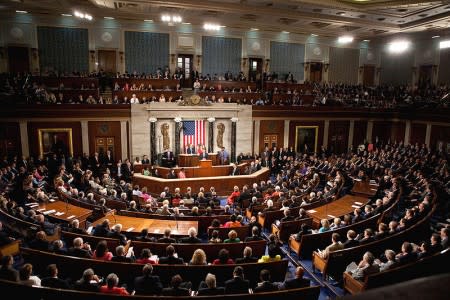Congress remains unpopular, inactive in mid-term year
The latest polling data on Congress, the least popular branch of government, shows that voters remain unhappy with lawmakers on a historic level, but may be less likely to vote this November.
Last July, we profiled the general dissatisfaction with the federal lawmakers, after Senate majority leader Harry Reid said Americans liked North Korea more than the current Congress.
It turned out that in a post-analysis of Reid’s comment that he might have overstated any American affection for the regime of Kim Jong-un, the basketball-loving North Korean dictator.
But a wide range of sources still show that most Americans have soured on Washington lawmakers as important elections near in November, when voters will possibly hold Congress accountable for its recent actions.
Four recent popularity polls about Congress show an average approval rating of 12.8 percent for the lawmakers, and an average disapproval rating of 77.5 percent. The site Real Clear Politics combined data from Gallup, The Economist, Fox News and CBS News/The New York Times for that composite number.
Last July, the combined approval rating for Congress was 15.2 percent and the disapproval rating was 76.6 percent. The disapproval rating skyrocketed to 84.8 late last fall after a series of congressional budget battles, shutdowns and fiscal cliffs.
Gallup said last December that Congress ended its year by making recent history of some sorts – as the most unpopular Congress in the past 39 years, when it ended the year with an average approval rating of 14 percent.
“The Founders set up Congress to be an extension of the American public itself, with elected representatives sent to the nation’s capital to do the people’s bidding. Americans’ approval of the job Congress is doing has never been extremely high on any consistent basis in recent decades, but over the past several years, it has reached new lows,” the polling service noted.
Its current approval rating of 15 percent, says Gallup, will set up another historic first in November for Congress.
“The stability in this metric — it has not fluctuated much over the course of this year — suggests that the 435 House members and one-third of the Senate who face re-election could do so amid the lowest congressional approval ratings for a midterm election in modern political history. Gallup historically has found that low congressional approval ratings are associated with higher congressional turnover,” the group says.
The Washington Post looked at more of the Gallup data and noted an interesting contrast: While 22 percent of Gallup responders wanted to fire the entire Congress, the reality is that almost all incumbents running for re-election, with the high-profile exception of Eric Cantor, survived the primary season so far.
But will voters make good on the threat to toss out the incumbents? According to new data from the Center for the Study of the American Electorate, primary turnout has also been at record lows this year, which could be a sign of low voter turnout in November.
If that trend holds true, then well-organized and funded groups could have a bigger impact on elections for seats in the House and Senate.
Heading into November, little is expected in the way of legislation from a Congress that could set another record, this one for the fewest laws passed by a sitting body in the past 40 years.
According to data from GovTrack.US, the current Congress has sent 127 laws to the President’s desk in the past 18 months. The lowest number of laws passed and signed by a sitting Congress, in a two-year session, was 284 laws – the low mark set by the prior 2011-2012 Congress.
Recent Stories on Constitution Daily
D.C. Court strikes down key part of Obamacare funding
10 fascinating facts about the Scopes Monkey Trial
Constitution Check: Are the Guantanamo war crimes courts now doomed?



